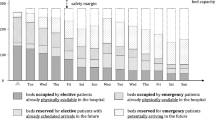Abstract
Hospital beds are a scarce resource and always in need. The beds are often organized by clinical specialties for better patient care. When the Accident & Emergency Department (A&E) admits a patient, there may not be an available bed that matches the requested specialty. The patient may be thus asked to wait at the A&E till a matching bed is available, or assigned a bed from a different specialty, which results in bed overflow. While this allows the patient to have faster access to an inpatient bed and treatment, it creates other problems. For instance, nursing care may be suboptimal and the doctors will need to spend more time to locate the overflow patients. The decision to allocate an overflow bed, or to let the patient wait a bit longer, can be a complicated one. While there can be a policy to guide the bed allocation decision, in reality it depends on clinical calls, current supply and waiting list, projected supply (i.e. planned discharges) and demand. The extent of bed overflow can therefore vary greatly, both in time dimension and across specialties. In this study, we extracted hospital data and used statistical and data mining approaches to identify the patterns behind bed overflow. With this insight, the hospital administration can be better equipped to devise strategies to reduce bed overflow and therefore improve patient care. Computational results show the viability of these intelligent data analysis techniques for understanding and managing the bed overflow problem





Similar content being viewed by others
References
Cattani, K., Schmidt, G. M. The pooling principle. INFORMS Trans. Ed. 5(2). 2005.
Whitt, W., Partitioning customers into service groups. Manag. Sci. 45:579–1592, 1991.
Kao, E. P. C., and Tung, G. C., Bed allocation in a public health care delivery system. Manag. Sci. 27:507–521, 1981.
Gorunescu, F., McClean, S. I., and Millard, P. H., A queueing model for bed-occupancy management and planning of hospitals. J. Oper. Res. Soc. 53:19–24, 2002.
Harper, P. R., and Shahani, A. K., Modelling for the planning and management of bed capacities in hospitals. J. Oper. Res. Soc. 53:11–18, 2002.
Cochran, J., and Roche, K., A queuing-based decision support methodology to estimate hospital inpatient bed demand. J. Oper. Res. Soc. 59:1471–1482, 2007.
Teow, K. L., Tan, W. S. Allocation of hospital beds in an existing hospital. JOL;2;2. 2008.
Wang, Y., Hare, W. L., Vertesi, L., Rutherford, A. R. Using simulation to model and optimize acute care access in relation to hospital bed count and bed distribution. Journal of Simulation 1–10. 2010.
El-Darzi, E., Vasilakis, C., Chaussalet, T., and Millard, P. H., A simulation modelling approach to evaluating length of stay, occupancy, emptiness and bed blocking in a hospital geriatric department. Health Care Manag. Sci. 1:143–149, 1998.
Huang, X. M., Decision making support in reshaping hospital medical services. Health Care Manag. Sci. 1:165–173, 1998.
Harrison, G. W., Shafer, A., and Mackay, M., Modelling variability in hospital bed occupancy. Health Care Manag. Sci. 8:325–334, 2005.
Tan, P.-N., Steinbach, M., Kumar, V. Introduction to data mining. Pearson-Addison Wesley, 2006.
Godfrey, K., Simple linear regression in medical research. N. Engl. J. Med. 313(26):1629–1636, 1985.
Kaur, H., and Wasan, S. K., Empirical study on applications of data mining techniques in healthcare. J. Comput. Sci. 2(2):194–200, 2006.
Kitsantas, P., Hollander, M., and Li, L., Using classification trees to assess low birth weight outcomes. Artif. Intell. Med. 38:275–289, 2006.
Harper, P. R. A review and comparison of classification algorithms for medical decision making. Health Policy, (71); 315–331, 2005.
Berry, M., and Linoff, G., Mastering data mining: the art and science of customer relationship management. Wiley, New York, NY, 1999.
Lim, T., Loh, W., and Shih, Y., A comparison of prediction accuracy, complexity and training time of thirty-three old and new classification algorithms. Mach. Learn. 40:203–228, 2000.
Perner, P., Zscherpel, U., and Jacobsen, C., A comparison between neural networks and decision trees based on data from industrial radiographic testing. Pattern Recogn. Lett. 22:47–54, 2001.
Lee, V. J., Lye, D. C., Sun, Y., and Leo, Y. S., Decision tree algorithm in deciding hospitalization for adult patients with dengue haemorrhagic fever in Singapore. Trop. Med. Int. Health 14(9):1154–1159, 2009.
Evenden, D., Harper, P. R., Brailsford, S. C., and Harindra, V., Improving the cost effectiveness of Chlamydia screening with targeted screening strategies. J. Oper. Res. Soc. 57:1400–1412, 2006.
Chien, C. W., Lee, Y. C., Ma, T., Lee, T. S., Lin, Y. C., Wang, W., and Lee, W. J., The application of artificial neural networks and decision tree model in predicting post-operative complication for gastric cancer patients. Hepatogastroenterology 55(84):1140–1145, 2008.
Bellazzi, R., and Zupan, B., Predictive data mining in clinical medicine: Current issues and guidelines. Int. J. Med. Inform 77(2):81–97, 2008.
Ridley, S. A., Jones, S., Shahani, A., Brampton, W., Nielsen, M., and Rowan, K., Classification trees: A possible method for iso-resource grouping in intensive care. Anaesthesia 53:833–40, 1998.
Isken, M. W., and Rajagopalan, B., Data mining to support simulation modeling of patient flow in hospitals. J. Med. Syst. 26(2):179–197, 2002.
Abbi, R., El-Darzi, E., Vasilakis, C., and Millard, P., Length of stay based grouping and classification methodology for modelling patient flow. JOL 2:2, 2008.
Testik, M. C., Ozkaya, B. Y., Aksu, S., Ozcebe, O. I. Discovering blood donor arrival patterns using data mining: A method to investigate service quality at blood centers. J. Med Syst. Published on line: 18 May 2010.
CRoss Industry Standard Process for Data Mining. http://www.crisp-dm.org/. Accessed on 1 July 2010.
Jordan, W. C., and Graves, S. C., Principles on the benefits of manufacturing process flexibility. Manag. Sci. 41(4):577–594, 1995.
Author information
Authors and Affiliations
Corresponding author
Rights and permissions
About this article
Cite this article
Teow, K.L., El-Darzi, E., Foo, C. et al. Intelligent Analysis of Acute Bed Overflow in a Tertiary Hospital in Singapore. J Med Syst 36, 1873–1882 (2012). https://doi.org/10.1007/s10916-010-9646-1
Received:
Accepted:
Published:
Issue Date:
DOI: https://doi.org/10.1007/s10916-010-9646-1




